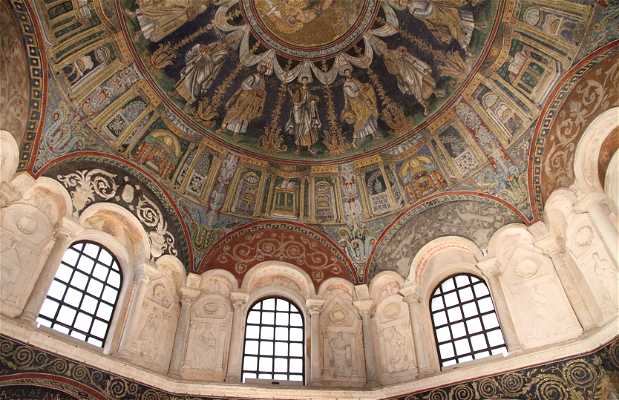ANADEL
Neoniano Baptistery (Italian, Baptistry...
El Baptisterio Neoniano (en italiano,...
El Baptisterio Neoniano (en italiano, Battistero Neoniano) es la más antigua de las ocho estructuras de Rávena inscritas en la lista del Patrimonio de la Humanidad en 1996. Según la evaluación ICOMOS de este patrimonio, este es «el mejor y más completo ejemplo superviviente de un baptisterio de los primeros tiempos del Cristianismo» que «retiene la fluidez en la representación de la figura humana derivada del arte greco-romano».
En parte se construyó sobre una terma romana. También se le llama Baptisterio ortodoxo (en italiano, degli Ortodossi) para distinguirlo del Baptisterio arriano construido a instancias del rey ostrogodo Teodorico unos cincuenta años más tarde. Los dos edificios, aun destinándose a la misma función, eran cada uno propio de una de las dos comunidades cristianas que coexistían entonces en Rávena. Se le llamaba «ortodoxo» entendido en el sentido de la época, que se refería a los cristianos de la «recta» doctrina en contraposición a la «herejía» arriana.
Con el paso de la sede episcopal de Classe a Rávena a finales del siglo IV, se inició una nueva catedral, la catedral Ursiana (por el nombre del obispo Urso), de la que sobreviven pocos restos englobados dentro de la actual catedral de Rávena.
La estructura es de planta centralizada octogonal, puesto que estamos ante un baptisterio, es de ladrillo fue construida por el obispo Urso a finales del siglo IV o principios del V, como parte de su gran basílica (destruida en 1734). El baptisterio fue concluido por el obispo Neón a finales del siglo V, tiempo en el que se añadieron las decoraciones en mosaico. El suelo original queda ahora 3 metros bajo tierra, de manera que la estructura propiamente dicha y la extensión del edificio ya no pueden verse más. El baptisterio tenía una función de propaganda a fin de incitar a las gentes a hacerse bautizar.
Neoniano Baptistery (Italian, Baptistry Neoniano) is the oldest of eight Ravenna structures inscribed on the list of World Heritage Site in 1996. According to the ICOMOS evaluation of this patrimony, this is "the best and most complete surviving example of a baptistery of the earliest times of Christianity" which "retains the fluidity in the representation of the human figure derived from Greco-Roman art." In part it was built on a Roman bath. Also called Orthodox Baptistery (Italian degli Ortodossi) to distinguish it from the Arian Baptistry constructed on behest of Ostrogothic King Theodoric some fifty years later. The two buildings, even for the in same function, were each unique to one of the two Christian communities coexisted then in Ravenna. It was called "orthodox" in the sense understood at the time, he was referring to the Christians of the "straight" doctrine as opposed to the "heresy" Arian. Over the episcopal see of Classe Ravenna to the late fourth century, began a new cathedral, the cathedral Ursiana (for the bishop's name Urso), of which few remains survive encompassed within the present cathedral of Ravenna. The structure is octagonal central plant, since this is a baptistery, is brick was built by Bishop Urso late fourth century or the beginning of V, as part of his great Basilica (destroyed in 1734). The baptistery was finished by Bishop Neon in the late V, time in which added the mosaic decorations. The original floor is now three meters underground, so the structure itself and the extension of the building and can not be more. The baptistery was a function of propaganda to incite the people to be baptized.



+2




